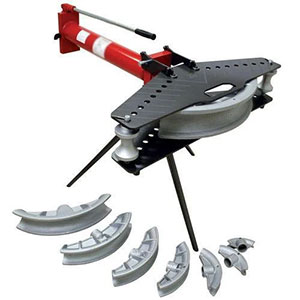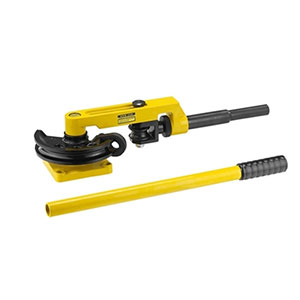How to Use a Pipe Bender?
Operators must pass the exam and obtain an operating certificate before performing any operations. Operators should be familiar with the performance and structure of the pipe bending machine and adhere to safety and shift handover procedures. In this article, ATO industrial automation will introduce the usage and maintenance method of pipe bender to help you use it more effectively.
Usage Method of Pipe Bender
- Pre-start preparation:
- Check the condition of hydraulic oil pipes and electrical wires between the electric hydraulic control box and the main machine.
- Inspect the lubricating oil indicators for the gearbox and electric hydraulic control box; add oil if below the standard value.
- Add clean lubricating oil (grease) to various lubrication points according to the lubrication diagram.
- Clean the site and check if moving parts can move freely within their range.
- Start-up and trial run:
- Place the hydraulic control valve in the neutral position, start the main motor and oil pump motor, and check if the motor rotation is normal.
- Check the gearbox for normal operation and ensure there is no sticking in the clutch and brake.
- Verify the normal operation of the oil pump, check for any crawling of the hydraulic cylinder piston, oil leakage, and air in the pressure pipeline; ensure the pressure indicated on the pressure gauge is normal.
- Verify the correctness and reliability of all operation buttons and angle limit mechanisms.
- After a trial run by pressing each button in the work cycle, and confirming everything is normal, the machine can be used for regular operations.
- Normal operation:
- Select and install the pipe die based on the bending diameter and radius.
- Install guide rollers and clamping dies based on the bending diameter.
- Install the bending mandrel based on the inner diameter of the bent pipe; the clearance between the bending mandrel and the pipe should not be too large, generally controlled between 0.5mm to 0.75mm.

- Adjust the left and right positions of the mandrel to make its centerline tangent to the bending die.
- Adjust the forward and backward position of the mandrel to correctly determine the lead value (L) of the mandrel head relative to the center of the bending die. The accuracy of L directly affects the ellipticity of the bent pipe. L should not be too large; otherwise, it may cause the machine parts to be damaged due to inability to bend, or the outer wall of the pipe may stretch too much, causing the pipe wall to rupture.
- Adjust the guiding mechanism, first place the hydraulic cylinder at the top dead center, move the slide to the final position, fix the supporting block in the new position, and adjust the screw rod to make the guide wheel just touch the bent pipe. Tighten the screw nut and support screw.
- Adjust the angle control mechanism. Set the bending starting point limit switch block to fix at the 0-line, then sequentially move three bending endpoint limit switch blocks according to the selected left or right bending process, fix the angle module according to the required bending angle, and refer to the scale on the ruler for calibration.
- Start the motor, insert the pipe to be bent onto the mandrel, and press the corresponding buttons on the control panel to bend the finished pipes as needed.
- When bending is complete, clean the pipe bending machine, keep the machine clean, cut off the power supply, and perform maintenance work.
Daily Maintenance of the Pipe Bender
- Check buttons, knobs, and indicator lights to ensure they are fixed without loosening, buttons can be pressed and knobs can be rotated smoothly, and indicator lights are bright with correct colors and clear colors, and contact points are in good condition with reliable operation.
- Check the condition of oil pipes and electrical circuits between the electric hydraulic control box and the main machine. Ensure that there is no damage to the oil pipes, firm connections without leaks, and no exposed wires.
- Check the oil pump for normal operation, with normal sound, and no oil leakage at the oil seal.
Inspect the oil tank, keeping the oil clean, and maintaining the proper oil level. - Check all oil valves for sensitive movement, coordination in the entire hydraulic cycle, and no leaks at the joints.
- Check the pressure gauges in all oil circuits; the dial should be clean, the displayed pressure should be sensitive and reliable, and the cutoff adjustment should be appropriate.
- Clean the surfaces of all sliding and rotating parts and perform lubrication daily.
- Wipe the body, control console, molds, and accessories clean after each shift.
Primary Maintenance of the Pipe Bender
The machine tool undergoes a primary maintenance every 4 to 6 months, with a maintenance duration of 8 hours, primarily led by operators and supported by maintenance personnel.
- Use a 500-volt megohmmeter to test the insulation resistance to ground of electrical components and switch circuits, ensuring it is not less than 0.5 ohms.
- Inspect contactors, intermediate relays, transformers, capacitors, thermal relays, limit switches, etc., ensuring they are securely installed, operate sensitively and reliably, with no noise, good insulation, and no overheating or aging phenomena.

- Use a 500-volt megohmmeter to check the internal and winding insulation of the test motor, ensuring there is no dust or grease inside, no traces of rubbing on the core of the stator and rotor, secure bundling of the lead wires at the end of the rotor, and insulation resistance values between windings and to ground should be greater than 0.5 ohms.
- Check and repair the main transmission system gears, shafts, and bearings for wear, abrasion, burrs, and deformation; remove grease and add lubricating grease.
- Check the clamping and guiding mechanism, ensuring that the slider moves freely back and forth, the guide wheel clamps and releases, and the guiding mechanism operates reliably.
- Clean the oil tank, filter the oil, and replace it based on oil quality.
- Check the oil cylinder, ensuring a smooth inner wall with no bulging, a securely fixed circular nut on the oil cylinder, and good elasticity of the flange-sealed O-ring with no oil leakage.
- Check and adjust geometric accuracy.
The above are the basic usage and maintenance methods of the pipe bender, please feel free to contact us if you have any question about our products, we will reply you as quickly as we can!

